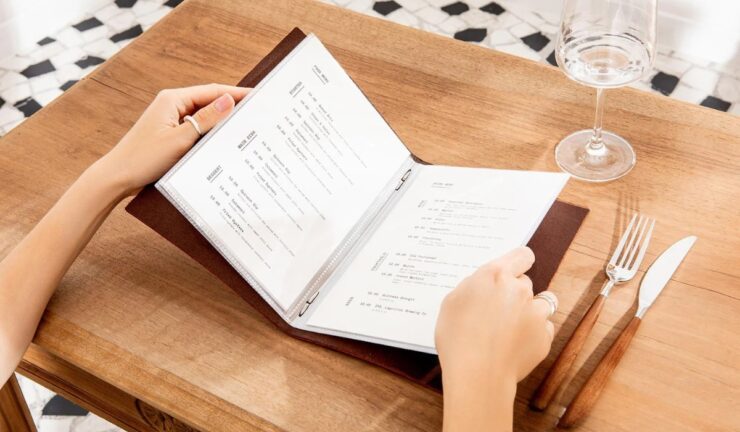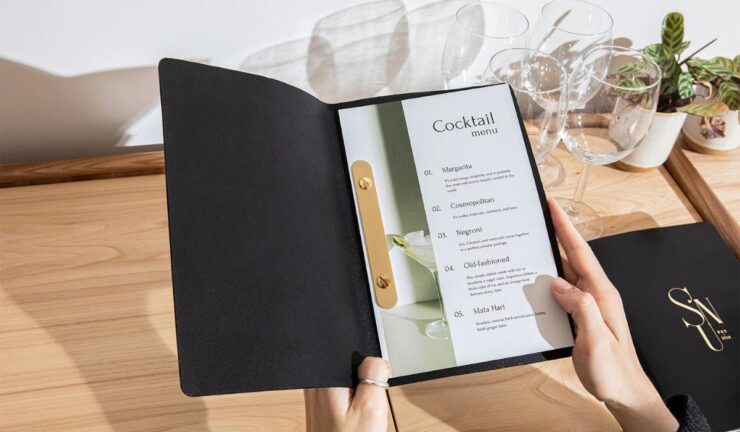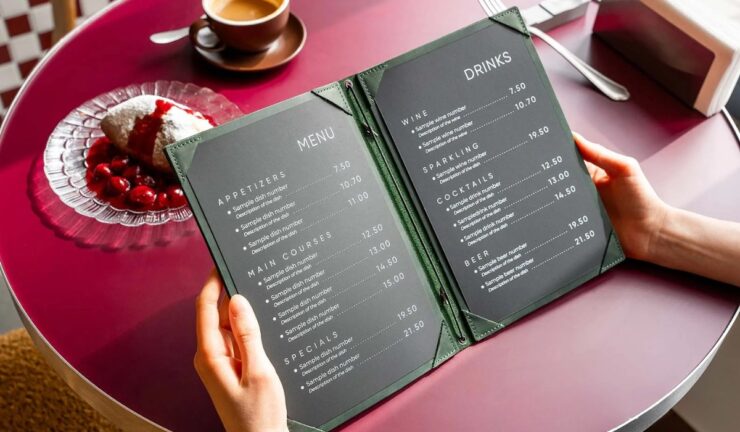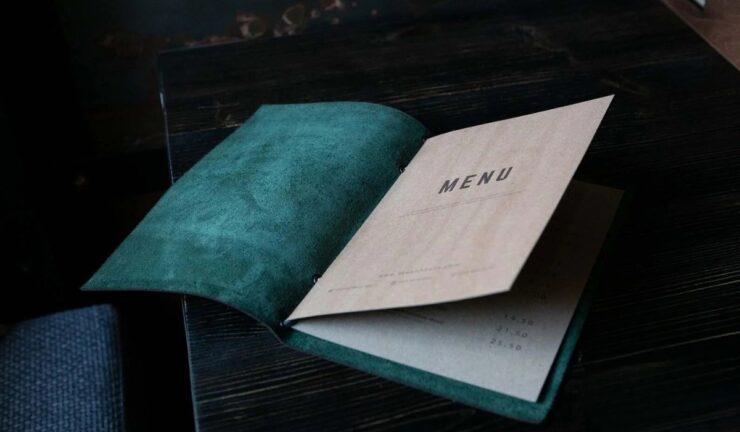In restaurant design, every detail counts, from the chairs guests sit on to the texture of the napkins. Menu covers are more than just protective accessories. They’re a design element that blends functionality with brand storytelling, creating a seamless visual experience from the moment guests are seated.
Guests don’t consciously analyze every detail of their dining environment, but they feel the effect of cohesive design. The moment a menu is placed on the table, the choice of material, color, and weight of the cover silently communicates what the restaurant stands for. Covers for menus speak a silent language: is the venue casual and approachable, premium and refined, or modern and daring? This unspoken message is part of what makes menu covers such a powerful tool for hospitality professionals.
In today’s competitive market, where diners expect not just a meal but an experience worth sharing, menu presentation has evolved into an essential piece of the overall branding puzzle.
2025 Design Trends for Menu Covers

1. Warm, Tactile Materials
In 2025, sensory engagement is key. Materials like genuine leather, brushed metal, cork, and reclaimed wood are at the forefront of design. These materials are not only durable but also invite guests to touch, feel, and connect.
Leather brings timeless elegance and pairs well with both fine dining and upscale casual spaces. Cork and reclaimed wood reflect eco-conscious values and create a rustic, approachable vibe. Brushed metal is increasingly popular in urban venues that want to emphasize sleekness and modernity.
This tactile quality enhances the overall dining experience by stimulating more than just the sense of taste. When the menu feels substantial and carefully made, it primes the guest to expect the same care in the dishes that follow.
2. Earthy and Neutral Color Palettes
Bold colors are taking a back seat as muted greens, sand tones, taupe, and deep browns dominate design choices. These tones are versatile, blending seamlessly into various interior styles while also creating a calming atmosphere.
Restaurants are moving away from glossy finishes in favor of matte or textured surfaces. These not only look sophisticated but also hide fingerprints and wear better over time, a practical consideration in high-traffic environments.
The shift toward earthy colors reflects a larger hospitality trend: creating spaces that feel grounding and authentic rather than flashy or overwhelming.
3. Minimalism with Subtle Branding
Oversized logos and heavy embellishments are out. Instead, restaurants are opting for debossed or engraved branding, tone-on-tone designs, or discreet foil stamping. This approach allows the craftsmanship of the cover itself to stand out without overwhelming the guest.
Minimalist branding also aligns with the guest’s desire for authenticity. Subtle details communicate confidence: a restaurant that doesn’t need to shout its name from the menu cover conveys quiet sophistication.
4. Multi-Material Accents
Designers are increasingly experimenting with combinations: wood frames with leather panels, linen textures with metal corners, or brass and copper accents that add warmth and character.
This trend mirrors what we see in modern interiors, layered textures that make spaces feel dynamic and thoughtfully composed. Multi-material covers can become a conversation starter at the table, reinforcing the idea that the restaurant pays attention to detail.
How to Match Menu Covers with Your Interior

Choosing the right cover isn’t just about aesthetics; it’s about harmony. The cover should feel like a natural extension of the space. Here are a few approaches:
- Fine dining spaces ─ Soft, full-grain leather in classic shades like deep burgundy, charcoal, or espresso brown creates a timeless, luxurious feel. Embossed or engraved logos add subtle prestige.
- Casual & rustic venues ─ Reclaimed wood or cork, sometimes combined with natural textiles, emphasize authenticity and eco-consciousness. Perfect for farm-to-table concepts.
- Modern minimalist restaurants ─ Matte metal finishes or smooth vegan leather in neutral tones like slate, sand, or ivory reinforce a clean, contemporary style.
- Outdoor dining & resorts ─ Weather-resistant synthetic materials with UV protection ensure the covers maintain their appearance despite exposure to sun, humidity, or frequent handling.
The choice should always circle back to the brand identity: what do you want guests to feel when they hold your menu?
Why Design Matters
A guest’s first tactile experience in your venue is often holding the menu. While food and service remain at the heart of hospitality, design choices shape expectations before the first dish arrives.
If the menu cover feels luxurious, it tells guests that attention has been paid to every aspect of their visit. If it feels flimsy or mismatched with the décor, it sends the opposite message. For many guests, this initial impression subconsciously influences their perception of the meal that follows.
In the age of Instagram and online reviews, details like menu covers can even become part of a guest’s social media storytelling. A thoughtfully designed menu cover that photographs well may find its way onto a diner’s feed, giving the restaurant free exposure.
Quick Tips for 2025 Menu Cover Styling
- Coordinate cover colors with tableware, upholstery, or even wall accents to create a cohesive look.
- Rotate seasonal covers, lighter colors and natural textures in summer, darker tones in winter, to keep the dining experience fresh.
- Ensure covers are easy to wipe clean, especially in high-turnover environments. Durability should always balance with aesthetics.
- Choose materials that age beautifully. Full-grain leather, for example, develops a rich patina over time, which can become part of the venue’s unique charm.
- Consider ergonomics: a cover that is too large or too heavy may frustrate guests, while one that is too small can look out of place on a spacious table.
The Business Case for Investing in Quality Menu Covers

Some operators may see menu covers as a minor detail, but their impact on guest perception, and by extension, revenue, is significant. Here’s why:
- Longevity and cost efficiency ─ Premium covers last longer, reducing the need for frequent replacements. Over time, this saves money compared to cheaper alternatives.
- Stronger branding ─ A customized cover reinforces your identity every time it’s placed in a guest’s hands.
- Guest satisfaction ─ Small details build into an overall positive impression, which leads to repeat business and stronger reviews.
- Operational ease ─ Well-designed covers with easy-insert systems reduce the stress of frequent menu changes.
Think of menu covers as part of your marketing budget rather than an operational expense. They’re a tool for brand storytelling that pays dividends through guest loyalty and word-of-mouth.
Final Thought
In 2025, covers for menus are as much about design as they are about durability. They’re no longer viewed as simple protectors for printed pages but as integral pieces of the dining atmosphere.
The right choice can elevate your interior, enhance guest perception, and make your brand unforgettable. Whether you opt for ready-to-ship options for quick solutions or fully customized designs that perfectly align with your concept, menu covers remain one of the most impactful small details in hospitality.
For restaurateurs, hoteliers, and designers alike, the message is clear: don’t overlook the menu cover. It’s the first handshake with your guest, and in hospitality, first impressions last the longest.

